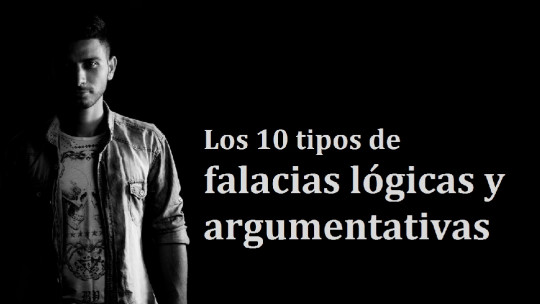
Philosophy and psychology are related to each other in many ways, among other things because they both address in one way or another the world of thought and ideas.
One of these points of union between both disciplines is in relation to the logical and argumentative fallacies, concepts used to refer to the validity (or lack thereof) of the conclusions reached in a dialogue or debate. Let’s see in more detail what they consist of and what the main types of fallacies are.
What are fallacies?
A fallacy is a reasoning that, despite appearing to be a valid argument, is not
This is, therefore, a line of reasoning that is erroneous, and the inferences presented as a result of these cannot be accepted. Regardless of whether the conclusion reached through a fallacy is true or not (it could be by pure chance), the process by which it was reached is defective, because it violates at least one logical rule.
Fallacies and psychology
In the history of psychology there has almost always been a tendency to overvalue our ability to think rationally, being subject to logical rules and showing consistency in our way of acting and arguing.
With the exception of certain psychological currents such as the psychoanalytic one founded by Sigmund Freud, it has been assumed that the adult and healthy human being acts according to a series of motives and reasoning that can be easily expressed textually and that normally fall within the framework of rationality. Cases in which someone behaved irrationally were interpreted either as a sign of weakness or as an example in which the person did not know how to identify the true reasons that motivated their actions.
It has been in recent decades when The idea that irrational behavior is located at the center of our lives has begun to be accepted, that rationality is the exception, and not the other way around. However, there is a reality that has already been giving us a clue to the extent to which we are moved by emotions and impulses that are little or not at all rational. This fact is that we have had to develop a kind of catalog of fallacies to try to ensure that these have little weight in our daily lives.
The world of fallacies belongs more to the world of philosophy and epistemology than to psychology, but while philosophy studies fallacies themselves, psychology can investigate the way in which they are used. Seeing to what extent false arguments are present in the speeches of people and organizations gives us an idea of the way in which the thinking behind them adheres more or less to the paradigm of rationality.
The main types of fallacies
The list of fallacies is very long and possibly there are some of them that have not yet been discovered because they exist in very minority or poorly studied cultures. However, there are some more common than others, so Knowing the main types of fallacies can serve as a reference to detect violations in the line of reasoning wherever they occur.
Below you can see a compilation of the most well-known fallacies. As there is no single way to classify them to create a system of types of fallacies, in this case they are classified according to their membership in two relatively easy to understand categories: non-formal and formal.
1. Non-formal fallacies
Non-formal fallacies are those in which the error in reasoning has to do with the content of the premises In this type of fallacies, what is expressed in the premises does not allow us to reach the conclusion reached, regardless of whether the premises are true or not.
That is, irrational ideas about how the world works are appealed to to give the impression that what is said is true.
1.1. Ad ignorantiam fallacy
In the ad ignorantiam fallacy, an attempt is made to take for granted the veracity of an idea for the simple fact that it cannot be proven false
The famous Flying Spaghetti Monster meme is based on this type of fallacy: since it cannot be proven that there is no invisible entity made of spaghetti and meatballs that is also the creator of the world and its inhabitants, it must be real.
1.2. Ad verecundiam fallacy
The ad verecundiam fallacy, or authority fallacy, links the veracity of a proposition to the authority of the person who defends it, as if that provided an absolute guarantee
For example, it is common to argue that Sigmund Freud’s theories about mental processes are valid because their author was a neurologist.
1.3. Ad consequentiam argument
In this type of fallacy, an attempt is made to show that the validity or not of an idea depends on whether what can be inferred from it is desirable or undesirable
For example, an ad consequentiam argument would be to assume that the chances of the army carrying out a coup d’état in a country are very low because the opposite scenario would be a serious blow to the citizens.
1.4. hasty generalization
This fallacy is a generalization not supported by sufficient data
The classic example is found in stereotypes about the inhabitants of certain countries, which can lead us to falsely think, for example, that if someone is Scottish they must be characterized by their stinginess.
1.5. anecdotal fallacy
As its name indicates, in the anecdotal fallacy the problem is that we start from anecdotal observations to reach conclusions. Here the problem is not so much the lack of information, as occurs in hasty generalization, but rather the poor quality of the information from which it is based.
For example, when we try to estimate the effectiveness of a type of psychotherapy based on our personal experience, we are falling into this type of fallacy, since we have not even adopted a scientific methodology to extract information in a systematic way about the effectiveness of that procedure, nor have we taken our biases into account.
1.6. straw man fallacy
In this fallacy, the opponent’s ideas are not criticized, but rather a caricatured and manipulated image of these ideas
An example would be found in a plot line in which a political formation is criticized for being nationalist, characterizing it as something very close to what Hitler’s party was.
1.7. Post hoc ergo propter hoc
This is a type of fallacy in which it is assumed that if one phenomenon occurs after another, it is caused by it, in the absence of more evidence indicating that this is the case
For example, one could try to argue that the sudden rise in the share price of an organization has occurred because the start of the big game hunting season has already arrived in Badajoz.

1.8. Ad hominem fallacy
Through this fallacy, the veracity of certain ideas or conclusions is denied, highlighting the negative characteristics (more or less distorted and exaggerated) of those who defend them, instead of criticizing the idea itself or the reasoning that led to it.
An example of this fallacy would be found in a case in which someone despises the ideas of a thinker arguing that he does not take care of his personal image.
However, You have to know how to distinguish this type of fallacy from legitimate arguments referring to the characteristics of a specific person. For example, appealing to the lack of university studies of a person who talks about advanced concepts of quantum physics can be considered a valid argument, since the information given is related to the topic of the dialogue.
1.9. Middle Ground Fallacy
In the middle ground fallacy, a supposedly equidistant position is adopted without taking into account whether all the information considered is equally valid and consistent.
For example, if we are informed that a person has invented a new type of pseudotherapy and we are asked if this practice should be included in the public health system, we would be falling into the fallacy of the middle ground if we assumed that health services should give him the same importance as the forms of therapy already offered and that have demonstrated their effectiveness.
1.10. tu quoque fallacy
In this type of informal fallacy, The illusion of refuting an argument is created by pointing out that the person who proposes it does not act in a manner consistent with that idea
It can be understood as a variant of the ad hominem fallacy, since an attempt is made to disguise criticism of the person as criticism of their reasoning.
1.11. Fallacy of composition
This error in reasoning occurs when we try reach conclusions about an element based on assessments about one of its parts For example:
2. Formal fallacies
Formal fallacies are fallacies not because the content of the premise does not allow us to reach the conclusion reached, but because the relationship between the premises makes the inference invalid
That is why its failures do not depend on the content, but on the way in which the premises are linked, and they are not false because we have introduced irrelevant and unnecessary ideas into our reasoning, but because there is no coherence in the arguments we use.
The formal fallacy can be detected by replacing all the elements of the premises with symbols and seeing if the reasoning conforms to the logical rules.
2.1. Denial of antecedent
This type of fallacy is based on a conditional such as “if I give him a gift, he will be my friend.” and when the first element is denied, it is incorrectly inferred that the second is also denied: “if I don’t give him a gift, he won’t be my friend.”
2.2. Affirmation of the consequent
In this type of fallacy we also start from a conditional, but in this case the second element is stated and it is incorrectly inferred that the antecedent is true:
“If I pass, I pop the champagne.”
“I pop the champagne, so I approve.”
23. Undistributed middle term
In this fallacy the middle term of a syllogism, which is the one that connects two propositions and does not appear in the conclusion does not cover all the elements of the set in the premises.
Example:
“Every Frenchman is European.”
“Some Russian is European.”
“Therefore, some Russian is French.”








